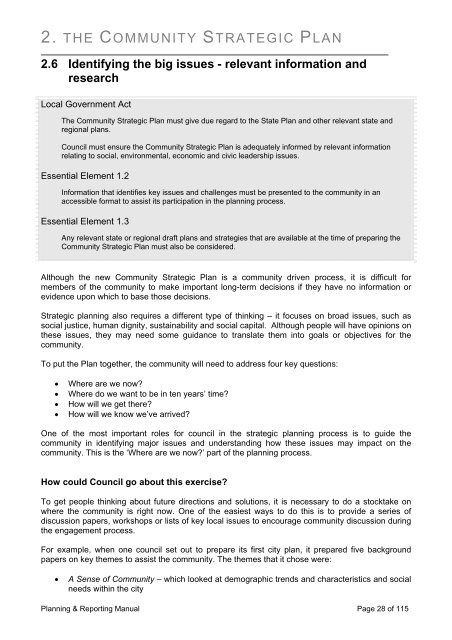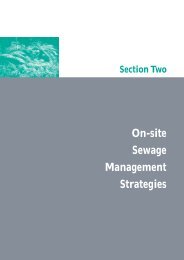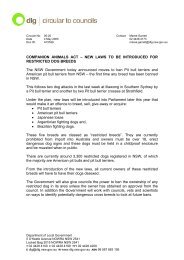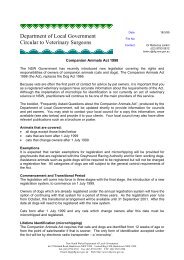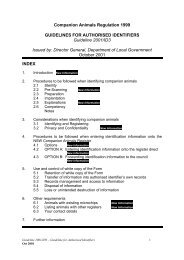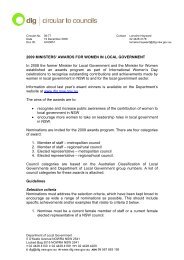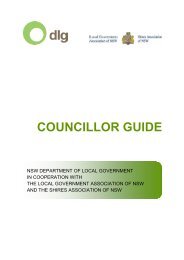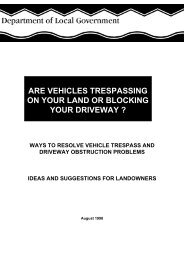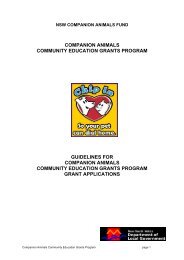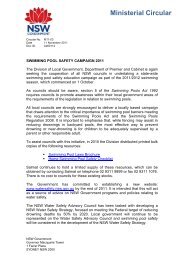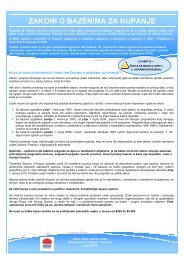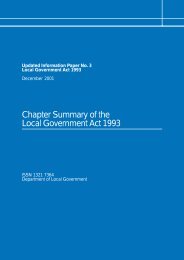Integrated Planning and Reporting Manual - Division of Local ...
Integrated Planning and Reporting Manual - Division of Local ...
Integrated Planning and Reporting Manual - Division of Local ...
You also want an ePaper? Increase the reach of your titles
YUMPU automatically turns print PDFs into web optimized ePapers that Google loves.
2. THE COMMUNITY STRATEGIC PLAN<br />
2.6 Identifying the big issues - relevant information <strong>and</strong><br />
research<br />
<strong>Local</strong> Government Act<br />
The Community Strategic Plan must give due regard to the State Plan <strong>and</strong> other relevant state <strong>and</strong><br />
regional plans.<br />
Council must ensure the Community Strategic Plan is adequately informed by relevant information<br />
relating to social, environmental, economic <strong>and</strong> civic leadership issues.<br />
Essential Element 1.2<br />
Information that identifies key issues <strong>and</strong> challenges must be presented to the community in an<br />
accessible format to assist its participation in the planning process.<br />
Essential Element 1.3<br />
Any relevant state or regional draft plans <strong>and</strong> strategies that are available at the time <strong>of</strong> preparing the<br />
Community Strategic Plan must also be considered.<br />
Although the new Community Strategic Plan is a community driven process, it is difficult for<br />
members <strong>of</strong> the community to make important long-term decisions if they have no information or<br />
evidence upon which to base those decisions.<br />
Strategic planning also requires a different type <strong>of</strong> thinking – it focuses on broad issues, such as<br />
social justice, human dignity, sustainability <strong>and</strong> social capital. Although people will have opinions on<br />
these issues, they may need some guidance to translate them into goals or objectives for the<br />
community.<br />
To put the Plan together, the community will need to address four key questions:<br />
<br />
<br />
<br />
<br />
Where are we now<br />
Where do we want to be in ten years’ time<br />
How will we get there<br />
How will we know we’ve arrived<br />
One <strong>of</strong> the most important roles for council in the strategic planning process is to guide the<br />
community in identifying major issues <strong>and</strong> underst<strong>and</strong>ing how these issues may impact on the<br />
community. This is the ‘Where are we now’ part <strong>of</strong> the planning process.<br />
How could Council go about this exercise<br />
To get people thinking about future directions <strong>and</strong> solutions, it is necessary to do a stocktake on<br />
where the community is right now. One <strong>of</strong> the easiest ways to do this is to provide a series <strong>of</strong><br />
discussion papers, workshops or lists <strong>of</strong> key local issues to encourage community discussion during<br />
the engagement process.<br />
For example, when one council set out to prepare its first city plan, it prepared five background<br />
papers on key themes to assist the community. The themes that it chose were:<br />
<br />
A Sense <strong>of</strong> Community – which looked at demographic trends <strong>and</strong> characteristics <strong>and</strong> social<br />
needs within the city<br />
<strong>Planning</strong> & <strong>Reporting</strong> <strong>Manual</strong> Page 28 <strong>of</strong> 115


